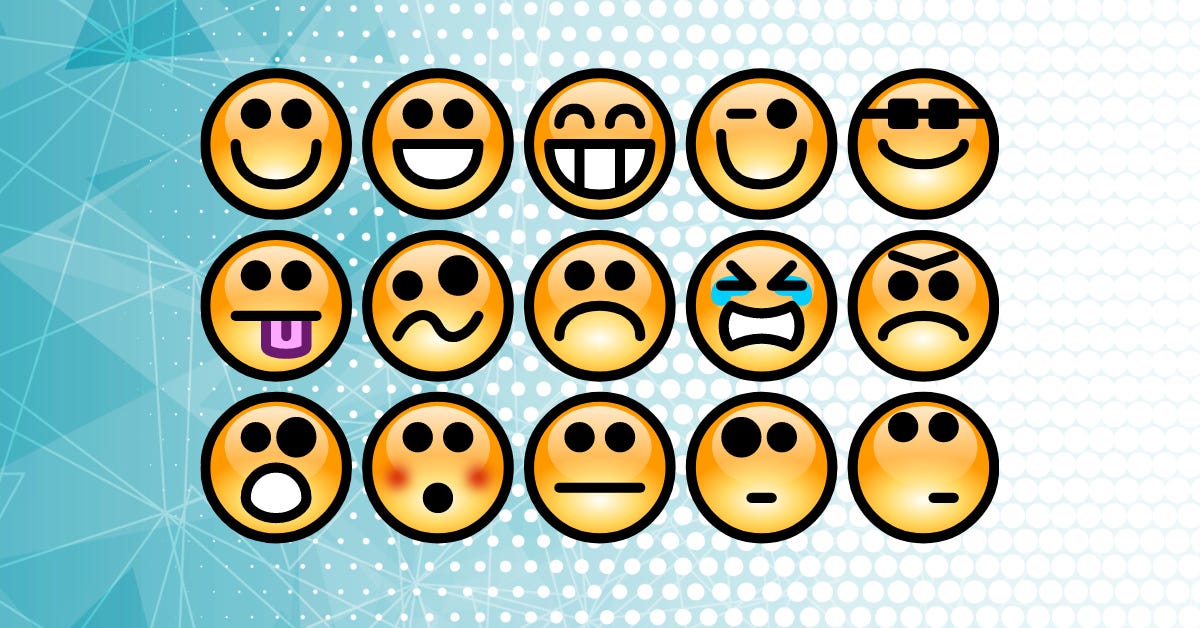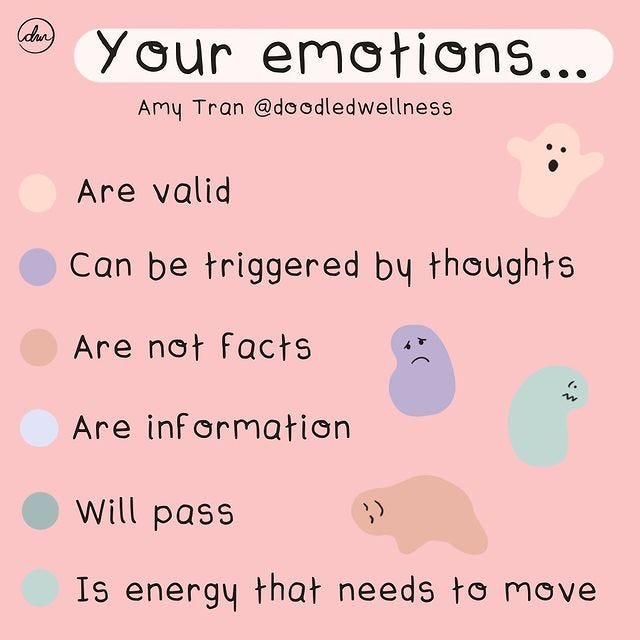Hello, friends! Earlier this month I wrote about Thoughtwork, and you sent me notes that it was useful and interesting. Thank you — so helpful! So today, let’s talk about another aspect of our inner experience that affects our health: emotions.
Emotions are SO powerful. Emotions occur every day to all of us.
You would think that something so omnipresent and influential would be a topic we studied from childhood: what emotions are, how to name them, how to be aware of them in our body, how to process them in a helpful way.
But, alas ... no. Very few of us get formal education on emotions. Often, the message we absorb is, unfortunately: Don’t talk about emotions at all. Ignore them! Or, we might get the message, especially as a little kid, that there are appropriate emotions and inappropriate emotions. (Why are you crying? Stop crying! Why are you angry? There’s no reason to be angry!)
As a grown-up, reading about emotions, I am often stunned by the revelations in books and podcasts: Wow — what? Why didn’t I learn this earlier! Everyone should learn this!
Emotions are physical
One revelation is the emotions are physical phenomenon.
“We often think of emotions as non-material, but they are a whole body experience,” as this PsychCentral primer puts it.
Think of how your body reacts when you are angry, what heats up, what feels tense, how your jaw or shoulder or stomach changes.
Think of how your body reacts when you are sad, how your energy level might fall, what parts might feel draining or drooping.
Think of how your reacts when you are happy, how your energy level might rise, how your face might change, how you might feel lighter and buoyant.
Emotions live in our bodies.
Emotions are not facts
This gets confusing, because both our thoughts and our emotions can feel like validating evidence. I’m angry because they did that on purpose! I’m frustrated because it should not be this way!
But emotions are not facts any more than our thoughts are. They are just emotions. They are just thoughts.
Separating our thoughts and our emotions from the facts can help us regulate both and see other options and perspectives from whatever bubbles up immediately.
Above, this is an Instagram account I discovered, @doodledwellness, with wonderful reminders and information from Amy Tran, an artist, therapist with a master’s in clinical psychology, and a PhD candidate.
Emotions can leave
Another revelation is that emotions, as a physical occurrence, don’t last long. Some experts estimate 90 seconds!
Dr. Jill Bolte Taylor, an author and neuroscientist, explains:
“Something happens in the external world, and chemicals are flushed through your body which puts it on full alert. For those chemicals to totally flush out of the body, it takes less than 90 seconds. This means that for 90 seconds you can watch the process happening, you can feel it happening, and then you can watch it go away.”
“After that, if you continue to feel fear, anger, and so on, you need to look at the thoughts that you’re thinking that are re-stimulating the circuitry that is resulting in you having this physiological reaction, over and over again.”
But when we think about the reason behind the emotion, we can end up stewing on the situation for a lot longer, and holding onto that feeling for hours or days. (Some experts divide “emotions” as the raw physical data and “feelings” as our interpretation of the emotion, how we judge and process and transfer that emotion into an understanding of the world.)
Have you heard the advice that when an unpleasant emotion hits you, to let it go through you? To notice it, and lean into it, and then let it disappear?
I had heard this multiple times, and honestly, I didn’t know what it really meant. The strong emotions I felt hung around for a while, maybe an hour, maybe a day. Sure, I noticed I was frustrated or happy — what more to it was there?
But then, one day recently, I had a moment when I understood.
A case study
It was a rainy day, and I was leaving the grocery, pushing the cart of bags as the drips fell on my head. The sky was gloomy, and I was feeling out of sorts. Then I felt a wave, an engulfing tsunami, of sadness. Immense melancholy. Loneliness. Grief.
I had no idea where it came from. Maybe it had something to do with cycles or hormones or the weather or a buried worried or an unconscious trigger of a sound or smell. I didn’t know, but I felt awful. This was not the flavor of awful that is the edge of a cleansing waterfall of tears. It was a solid state of awful, a stasis of sadness.
As I was pushing the cart back to the cart tent, under the slate gray sky, I remembered that advice, which I had read a hundred times but that had never made any sense to me: Let an emotion go through you, feel it, recognize it, name it, and then it will pass. Feelings last only a minute or two, supposedly.
That guidance always seemed utterly ridiculous. Feelings linger! They haunt with you! They coat the day!
But in this moment, in hopelessness and confusion, I decided to actually try it.
I told myself: You are SO sad. You feel AWFUL. And I tried to notice the sadness in my body, zoom in on wherever it was hiding, maybe in my tummy or shoulders or neck. I concentrated only on the sadness for a minute or two. I noticed it. I named it. I acknowledged it.
I did not try to exit it or run away from it.
I did not try to ignore it.
I did not judge it.
I did not think about why or why now or when it would end.
Instead, I felt the sadness, all of it, as I was walking in the rain back to my car.
And — you probably saw this coming — the SADNESS DISAPPEARED.
I do not know where it went! But it was gone! I was regular old me again, like I was a dusty window that had been Windexed clean. It was like I went through a tunnel and emerged on the other side, a hidden tunnel I did not know existed.
I was shocked.
Has this happened to you?
I haven't tried this again, but I will, the next time an unpleasant emotion comes unexpectedly.
Getting stuck in the tunnel of emotion
Most of us, myself included, likely don’t feel emotions in 90-second increments. They linger, and we can get stuck.
Emily Nagoski and Amelia Nagoski describe this as getting stuck in the tunnel of emotion by not completing the stress cycle. They detail all of this in their book, Burnout: The Secret to Unlocking the Stress Cycle, and spoke to Brené Brown on her podcast about it, too. (That podcast episode is so fantastic and enlightening — and only an hour — I would recommend it over the book.)
I wrote about the tunnel of emotion, too, here: How to complete the stress cycle.
Here’s how Emily and Amelia describe getting stuck in stress cycles over and over again:
“Let’s think about what this does to just one system, the cardiovascular: Chronically activated stress response means chronically increased blood pressure, which is like constantly turning a firehose on in your blood vessels, when those vessels were designed by evolution to handle only a gently flowing stream. The increased wear and tear on your blood vessels leads to increased risk for heart disease. That’s how chronic stress leads to life-threatening illness.
“And this happens, remember, in every organ system in your body. Digestion. Immune functioning. Hormones. We are not built to live in that state. If we get stuck there, the physiological response intended to save us can instead slowly kill us.”
The gist is that you need to help your body get through the tunnel of emotion and complete the stress cycle by doing something — going for a run, say, or venting to a friend, or crying. This resets your body, in essence, to let it know it is safe and can stop its protective, high-stress reaction.
Ways to complete the stress cycle
Physical activity
Breathing slowly, and exhaling long and full
Crying
Positive social connection
Genuine, full-out laughter
Affection, like 20-second real hugs
Creative expression, like writing, painting, dancing
This is not a complete list. You might have your own way of completing the stress cycle.
Back to you …
What works for you when you are stressed and need to get it out of your system?
Have you noticed that going for a run or walk, or calling a friend, or getting a long, real hug helps?
Do you think about your emotions? How do you handle them? What is helpful for you?
And what should we talk about next here? Help me pick the next topic of the Odyssey of the Body, or send me a note with a suggestion.
I hope you have a joyful week ahead. Please let me know what resonated here, if anything did — I always love to hear from you.
To our journeys,
Brianne






Thank you for this newsletter. I found Burnout wildly helpful, like you I found them via Brene Brown’s podcast. During the pandemic lockdowns I found listening to sad songs to trigger a burst of tears really helpful. I swear I cried daily for months, but only for a few minutes while paying attention to what I was feeling in my body rather than on dissecting emotions or thoughts. Then I would be fine again.